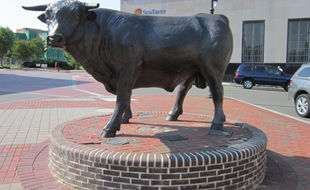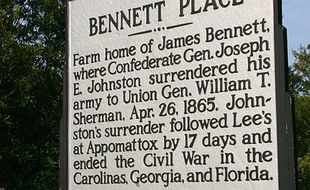Antebellum South

Dedicated in 2007 the Durham bull depicts a classic antebellum symbol of Durham, NC. It stands as a testament to Durham's prosperity and growth dedicated at a time when gentrification of the downtown area was just beginning to truly take off.


4409 Bennet Memorial Rd., Durham, NC
Home of the Bennett family, Bennett Place was originally a rather normal yeoman farm during the Civil War. It would gain fame as the largest site of a Confederate surrender during the Civil War. On April 17th, 18th, and 26th, of 1865, General Johnston negotiated the surrender of the Armies of Georgia, Florida, and the Carolinas (an army of 89,240). However this is also a monument to immigration. As both armies had to sit around in the Durham area for weeks many soldiers began to develop a taste for the local Lucky Strike cigarettes. This led to a great interest in Durham post-war and in turn rapid economic growth in the area. As happens with any economic hotspot, returning war veterans and other rural families moved in to the city hopeful to take advantage of the growing tobacco industry. The Unity Monument was built on the site in 1923 to commemorate the historic surrender and in 1970 Bennett's Place was added to the National Register of Historic Places. Bennet Place is officially a monument to the end of the Civil War but it also marks an important transition in Durham's history and the beginning of Durham's rural to urban migration.
